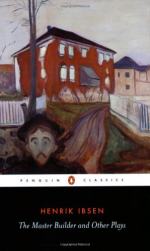|
This section contains 3,234 words (approx. 9 pages at 400 words per page) |

|
In the following essay, Hornby examines The Master Builder as a "point of departure" from the realist dramas of Ibsen's middle period to a combination of realism and romanticism that anticipated such twentieth-century movements as surrealism and expressionism.
It has long been known that Ibsen's late plays—The Master Builder, Little Ejolf, John Gabriel Borkman, and When We Dead Awaken—represent a departure from the famous realistic plays of his middle period. Even Bernard Shaw, who had been obsessively concerned with Ibsen the moralist, described Ibsen as now having "completed the task of warning the world against its idols and anti-idols," and instead having written "tragedies of the dead." But more than this, the late plays demonstrate Ibsen's greatness, both as a significant (though independent) figure in the Symbolist movement of the 1890s, and as a significant precursor of twentieth-century literary movements. In his late...
|
This section contains 3,234 words (approx. 9 pages at 400 words per page) |

|




